Reps could be missing out on 76% of qualified leads by not doing any follow-up activity. See what other data is saying with these sales follow-up statistics.
18 Sales Follow-up Statistics & Key Takeaways To Drive Revenue Going into 2024
This article is part of a larger series on Sales Management.
Sales follow-ups with leads after an initial conversation or cold email attempt are vital to close deals as they enable you to stay top-of-mind with decision-makers. The challenge comes down to ensuring you make your reconnection attempts using proper messaging, channels, and timing. Here are 18 sales follow-up statistics for 2023 that can help you optimize your nurture campaigns and messaging—-ultimately driving revenue numbers.
Lead Follow-up Statistics for Cadence & Activity
These sales follow-up stats are all about the input for a rep. While you can’t always control the outcome, you can control the amount of effort put into a single lead or opportunity, which can be measured by the number of touches and cadence of your follow-ups.
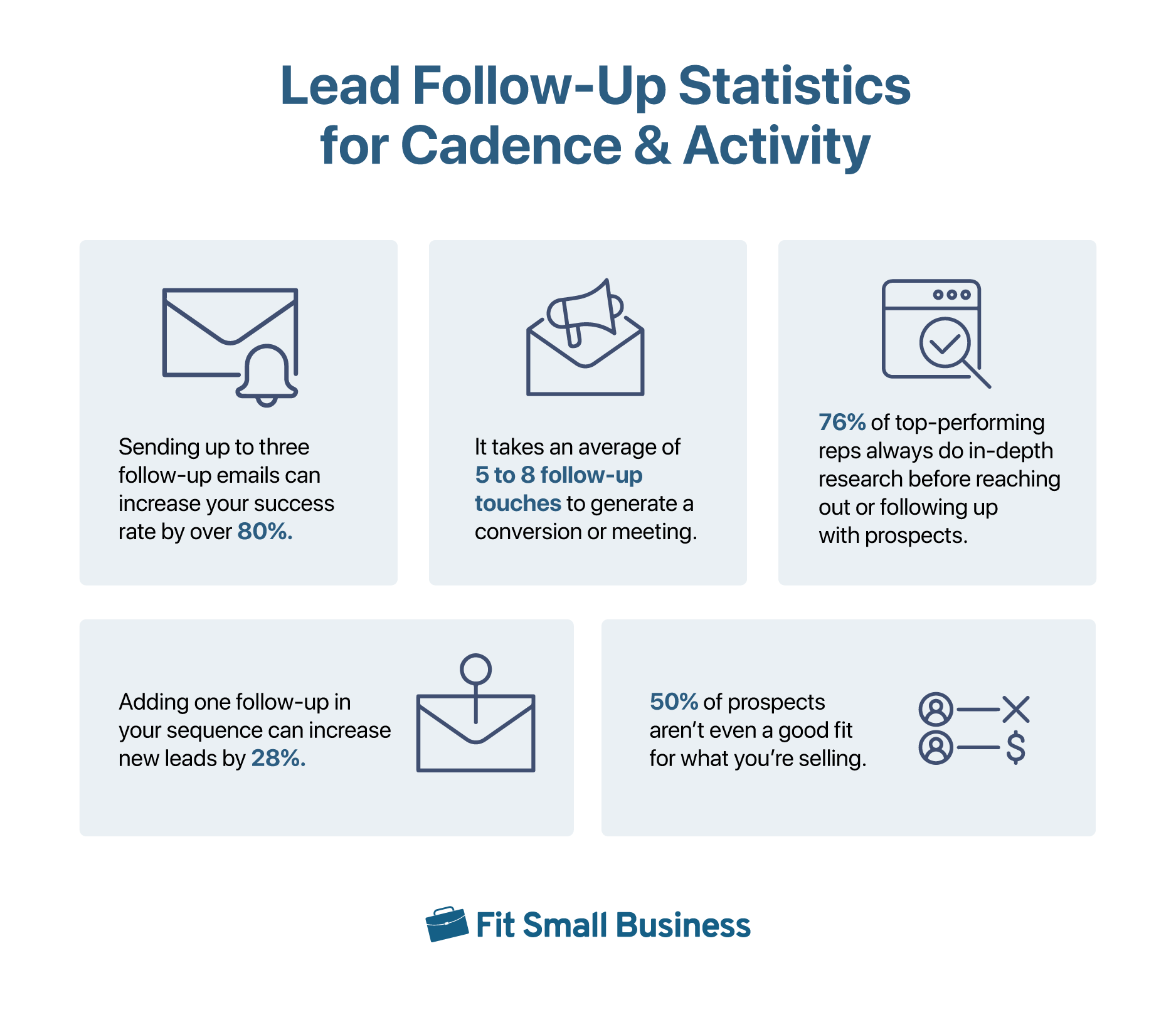
1. Sending up to three follow-up emails can increase your success rate by over 80%.
(Source: Sopro.io)
Takeaway: More than anything, this showed the value of persistence. If you’re a sales manager, you should be setting activity quotas that take this data into account. It’s not necessarily about reaching out to X number of prospects but doing X number of email touches to both new leads and ones you’ve already attempted to engage.
2. On average, it takes between 5 to 8 follow-up touches to generate a conversion or meeting.
(Source: RAIN Group)
Takeaway: Here’s another dataset that proves one-and-done doesn’t work in sales. Reps need to continuously call or email prospects after the first attempt to get a conversion, whether it’s a product demo, sales meeting, or an agreement by a prospect to accept additional marketing materials. Consider these activity inputs when planning out your task load for the week.
3. 76% of top-performing reps always do in-depth research before reaching out or following up with prospects.
(Source: LinkedIn)
Takeaway: This data was in comparison to only 47% of other sellers who do research before outreach campaigns. There is a clear relationship between putting in the time to prepare for follow-up touches and sales results. Because personalization and understanding the unique challenges of your prospects are vital to sales, reps should learn as much as they can about their leads before engaging and reengaging them.
4. Adding 1 follow-up in your sequence can increase new leads by 28%.
(Source: Sopro.io)
Takeaway: The data for these particular sales statistics on follow-ups evaluated the value of email sequences. While 70% of reps stop after one email, the study found 76% of all generated leads come from the first, second, or third “chaser” and not the initial introduction. The most notable finding was that just one follow-up is able to account for 28% of the entire lead pool. So what does this mean for you? Incorporate either manual or automated sequences in your sales campaigns.
5. 50% of prospects aren’t even a good fit for what you’re selling.
(Source: Sales Insights Lab)
Takeaway: This stat isn’t about how or when to follow up, but when to not follow up. Unless you’ve done your due diligence prior to the outreach campaigns, half of the lead pool should be removed from your follow-up sequences. We go back to the idea of in-depth research; you must take the time to understand each prospect and ensure they fit into your ideal customer profile.
Pro tip: Use customer relationship management (CRM) software like HubSpot to ensure reps are putting in the work for their follow-ups. These products offer sales reporting tools to track rep activity and evaluate lead conversion rates. This lets you make sure sales teams are doing the number of emails, calls, and meetings necessary to meet revenue goals.
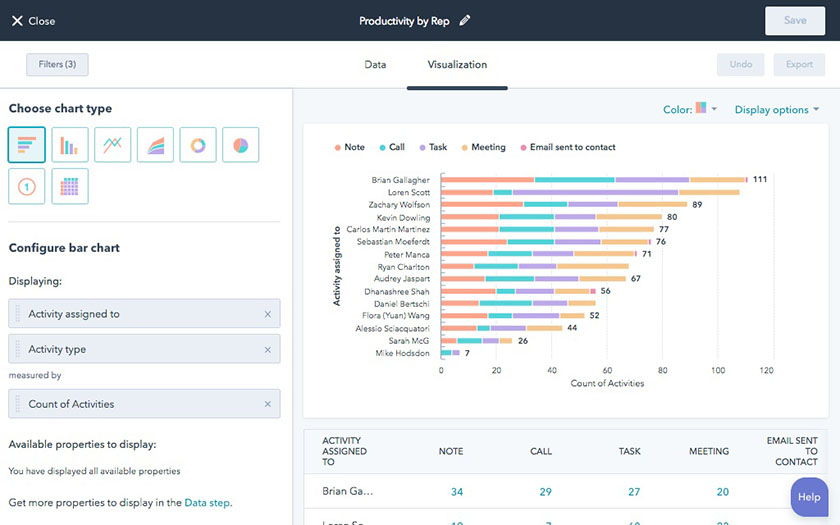
HubSpot CRM activity reporting by rep (Source: HubSpot)
AI & Sales Follow-up Statistics
Artificial intelligence (AI) is a significant emerging technology for sales reps to automate outreach, data management, and insights-gathering activities on leads—letting them do more in less time. As a tool for sales follow-ups, AI has become a key player in terms of outbound volume and messaging quality per these statistics.

6. Of those sales teams deploying AI in their sales operation, only 44% are using it for email generation and automation.
(Source: Outreach Sales)
Takeaway: This proves, more so, that there’s currently a usage gap for AI technology in sales follow-ups. While most businesses are applying AI for data management and analytics purposes, there is a huge opportunity to use generative AI for research and drafting personalized follow-up emails, then auto-deploying them on a mass scale.
7. 61% of sales reps agree that AI can help make prospecting and follow-ups more personalized.
(Source: HubSpot)
Takeaway: Another relatable stat from this survey was that 71% of reps agree AI can help salespeople reach the right prospects at the right time with the right messaging. AI is designed to complete tasks that a human would ordinarily do. So if an intelligent bot can get you personalized information on a lead and evaluate their habits, such as when they check their email inbox, those could be pertinent details in a follow-up campaign.
8. Ranked third, the top use for AI in sales is writing prospect cold emails and follow-up messages.
(Source: HubSpot)
Takeaway: AI is progressively proving useful in perfecting email messages. While you can use it to generate follow-ups on a mass scale and deploy them at the most opportune time, there’s also value in email quality control. As AI capabilities continue to improve, so will the content of email marketing campaigns.
Pro tip: Find a CRM system that deploys emerging technology like AI in its toolset. Products like HubSpot CRM, for example, have incorporated AI for many uses, including email generation. This lets you add simple follow-up inputs such as the message tone, what you’re selling, and your target audience so you can put email drafting on auto-pilot.
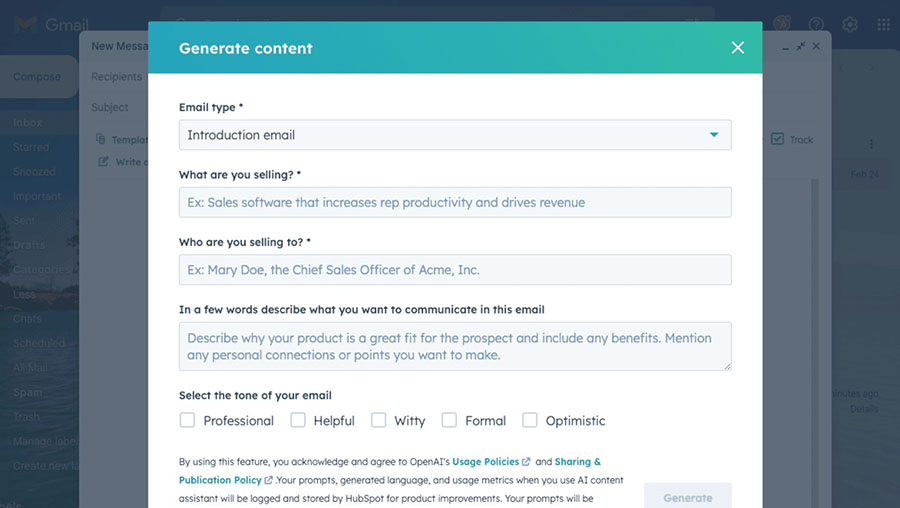
HubSpot AI email generator (Source: HubSpot)
Follow-up Stats on Contact Channels & Methods
In many cases, it’s not about “what” you say, but “how/where” you say it. It’s important to be able to understand buyer behavior and preferences so you can ensure you’re best connecting with decision-makers on the channels they will respond to. These sales stats dive into various approaches and communication methods you can use during follow-up campaigns.
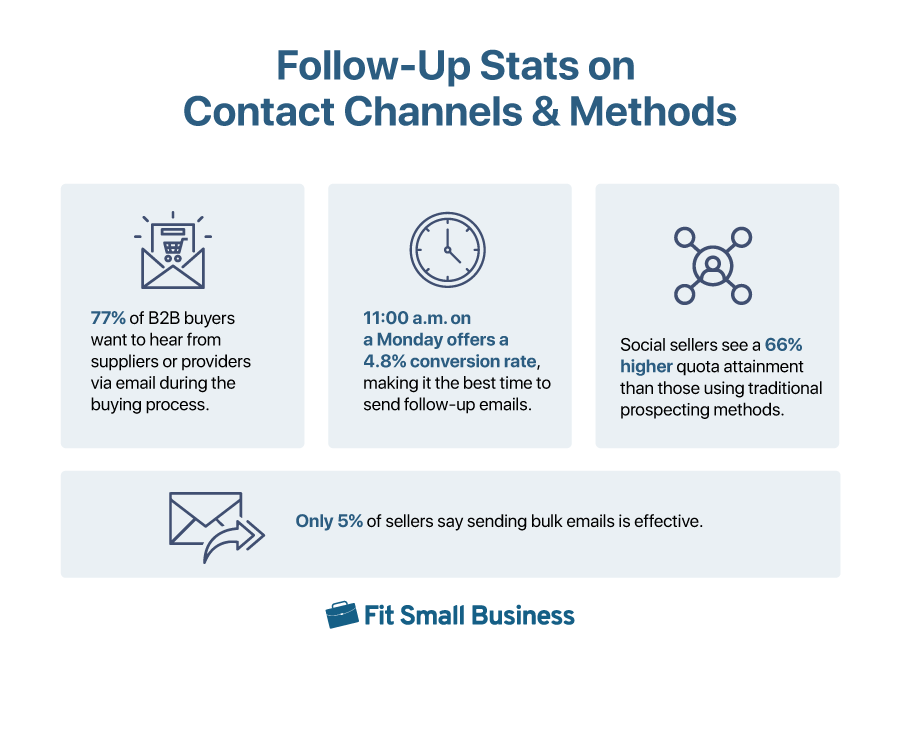
9. 77% of B2B buyers want to hear from suppliers or providers via email during the buying process.
(Source: Sopro.io)
Takeaway: When determining how you will follow up with prospects, consider the fact that most buyers prefer email as their primary contact method. This is likely due to the nonabrasiveness of the channel that allows a recipient to read and respond on their own time instead of an inbound phone call, which puts them on the spot.
10. 11 a.m. on a Monday offers a 4.8% conversion rate, making it the best time to send follow-up emails.
(Source: Sopro.io)
Takeaway: Many surveys and studies have been conducted to find the best time to send a prospect email. This one, however, took thousands of data sets spanning seven years and found that 11:00 a.m. on a Monday has the highest conversion rate. That said, we recommend using an automated email scheduler that deploys a mass set of personalized follow-ups at exactly this time.
11. Only 5% of sellers say sending bulk emails is effective.
(Source: RAIN Group)
Takeaway: This just validates the idea that personalization is vital for email follow-ups. Prospects can tell if an email is mass-produced and don’t feel any pressure to engage or respond with those messages. This, however, doesn’t mean you can’t send many individual messages at the same time. Email tools and CRM systems include features for auto-inserting personal data onto email templates that make it appear individualized but sendable on a mass scale.
12. Social sellers see a 66% higher quota attainment than those using traditional prospecting methods.
(Source: SalesforLife)
Takeaway: Leveraging social media platforms to engage leads lets you better understand their pain points and more easily distribute relevant content. This is most applicable through LinkedIn for business-to-business (B2B) sales. Apply social selling in your follow-up sequences to connect with prospects and reach out via LinkedIn.
Pro tip: Sales follow-ups can be done using various communication methods, including phone, email, chat, and social media platforms. Use a CRM like Freshsales that comes with an omnichannel contact center to engage leads using all types of communications.
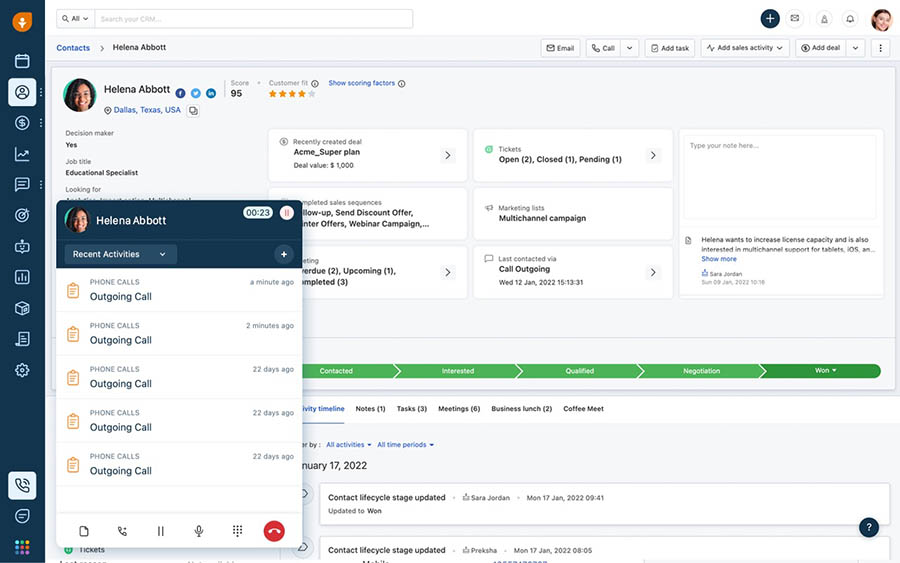
Freshsales built-in cloud phone system (Source: Freshworks)
Sales Follow-up Statistics on Content
Delivering the right message and content to leads helps keep them engaged. The result is either your business remaining in the running for a product or service, an appointment added to the calendar, or best-case scenario—finalizing a deal. These statistics outline how you should approach constructing the follow-up process and what should be included.
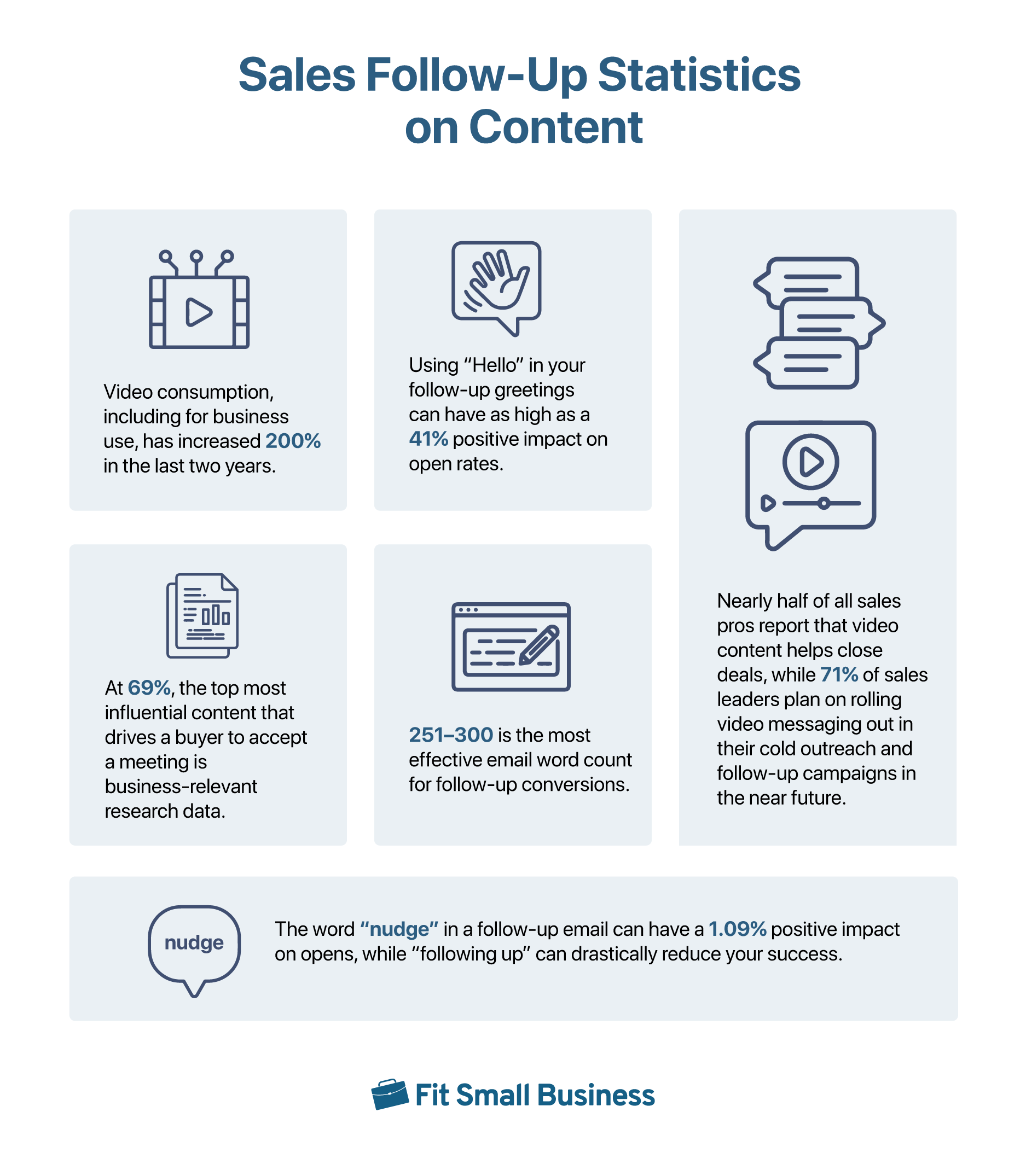
13. Video consumption, both for business and personal use, has increased 200% in the last 2 years.
(Source: HubSpot)
Takeaway: Video is becoming the way to engage leads and people in general. Due to its rising demand as a content source, consider using it in your follow-up campaigns. Rather than placing a warm call or sending an email with lengthy text, you can attach a video greeting to an email message of you personally reintroducing yourself and presenting how you can support that particular prospect.
14. Nearly half of reps say video content helps close deals, while 71% of leaders plan to roll out video messaging in their campaigns.
(Source: Vidyard)
Takeaway: Tying in with the previous stat, you’ll want to incorporate video for your follow-ups sooner rather than later. More and more sales teams will utilize video messaging in the near future, so it’s important to get on that train early before it no longer sticks out as a unique contact method.
15. Using “Hello” in your follow-up greetings can have as high as a 41% positive impact on open rates.
(Source: Sopro.io)
Takeaway: There’s always the question of what exactly to write in your email follow-up messages. Should you be formal, informal, or something in between? According to the data, using “Hello [NAME]” as a greeting has the highest positive impact on opens. Additionally, saying a less formal “Hi [NAME]” is used the most but has a 5% negative impact on opens.
16. At 69%, the top most influential content that drives a buyer to accept a meeting is business-relevant research data.
(Source: RAIN Group)
Takeaway: Just like you’re looking for statistics to back up how to do sales follow-ups, prospects want to see data before making their own decisions. Relevant data in email content has the most influence on conversions. As you make your follow-ups, be sure to conduct research both on the person contacted and in the industry you’re serving. Combine personalization with logic to encourage that lead to accept a meeting with you.
17. The word “nudge” in a follow-up email can have a 1.09% positive impact on opens, while “following up” drastically reduces success.
(Source: Sopro.io)
Takeaway: Email prospecting data showed that using “following up,” a common phrase in email follow-ups, can reduce open rates by as much as 16.3%. Additionally, “didn’t hear back” can reduce rates by 57.61%. What this data concluded was that “nudge” was the only reminder language that showed a positive open impact, so be sure to use it in your campaigns.
18. In terms of optimal email word counts, 251-300 is the most effective for follow-up conversions.
(Source: Sopro.io)
Takeaway: Many assume that the “less is more” principle applies to sales emails and follow-ups. Data, however, suggests otherwise. That 251–300 count is the sweet spot for getting email reads and replies. There’s a steady rise in conversion rates starting at 101 words until the 251-300 optimal zone. After 300 words, the conversion rates significantly plummet.
Pro tip: With email follow-ups, once you find what works, stick with it. CRMs like HubSpot offer email template storage where you can save and share optimal content outlines that get you the best results.
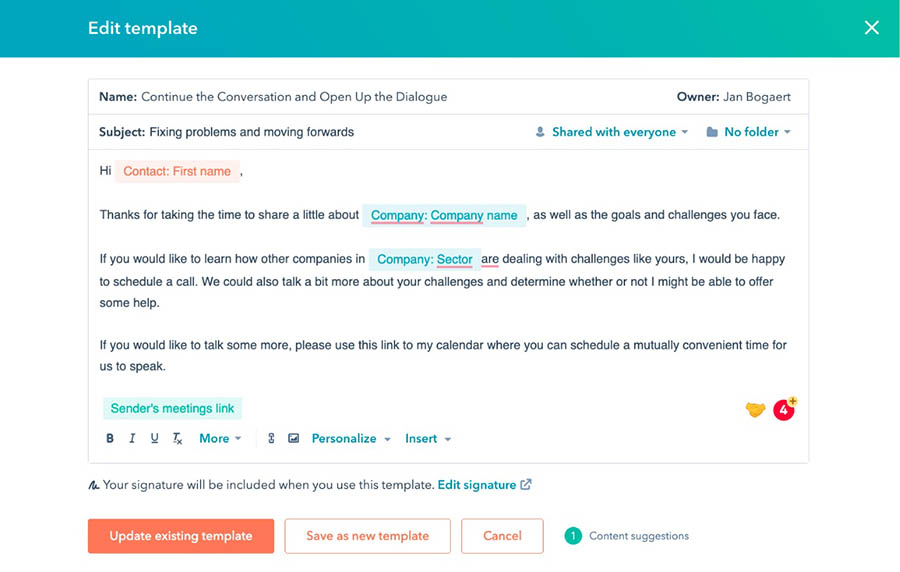
HubSpot CRM accessing a sales email template (Source: HubSpot)
Looking for other datasets to improve your overall sales posture? Here are 23 actionable sales statistics your small business can use for 2023.
Bottom Line
Per the data, sales follow-ups are key activity indicators for a successful revenue operation, assuming they’re done right. Be sure to incorporate these findings while developing a sales plan, setting goals, and constructing your messaging during outreach. In addition to multiple touches at optimal times, consider adding unique elements during follow-ups, such as video messages, social selling techniques, and AI tools.